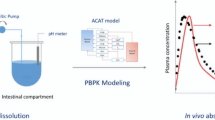Abstract
Purpose. The relationship between the pH, solubility, and partition coefficient was investigated to show that the product of intrinsic values of solubility and partition coefficient is equal to the product of total values of solubility and distribution coefficient at different pH.
Methods. The pH distribution profiles were obtained from the literature and the pH solubility profiles were obtained from the literature or calculated from their intrinsic solubility and pK a.
Results. The pH solubility and pH distribution coefficient profiles of 25 compounds were investigated to show that the product of intrinsic solubility (S w) and intrinsic octanol-water partition coefficient (K ow) is equal to the product of total solubility of a partially ionized solute (S T) and its octanol-buffer distribution coefficient (K D) at any pH where ion pair formation and salt precipitation are not present.
Conclusions. The fact that S w ⋅ K ow can be used instead of S T ⋅ K D to model the absorption of partially ionized drugs in the gastrointestinal tract has important biopharmaceutical implications.
Similar content being viewed by others
REFERENCES
J. B. Dressman, G. L. Amidon, and D. Fleisher. Absorption potential: Estimating the fraction absorbed for orally administered compounds. J. Pharm. Sci. 74:588–589 (1985).
K. Balon, B. U. Riebesehl, and B. W. Muller. Drug liposome partitioning as a tool for the prediction of human passive intestinal absorption. Pharm. Res. 16:882–888 (1999).
T. Sanghvi, N. Ni, and S. H. Yalkowsky. A simple modified absorption potential. Pharm. Res. 18:1794–1796 (2001).
S. H. Yalkowsky. Solubility and Solubilization in Aqueous Media. Oxford University Press, New York, 1999.
S. H. Yalkowsky. (1999) AQUASOL dATAbASE of Aqueous Solubility. University of Arizona, Arizona.
P. H. Howard and W. M. Meylan. Handbook of Physical Properties of Organic Chemicals. Lewis Publishers, New York, 1997.
Beilstein Commander for CrossFire 2000. MDL Information Systems, Inc., San Leandro, California, 2000.
S. Budavari. The Merck Index. Merck & Co., New Jersey, 1996.
J. Hadgraft and C. Valenta. pH, pKa and dermal delivery. Int. J. Pharm. 200:243–247 (2000).
P. Luger, K. Daneck, W. Engel, G. Trummlitz, and K. Wagner. Structure and physicochemical properties of meloxicam, a new NSAID. Eur. J. Pharm. Sci. 4:175–187 (1996).
Z. Chowhan. pH-solubility profiles of organic carboxylic acids and their salts. J. Pharm. Sci. 67:1257–1260 (1978).
A. Tsantili-Kakoulidou, I. Panderi, F. Csizmadia, and F. Darvas. Prediction of distribution from structure. 2. Validation of prologD, an expert system. J. Pharm. Sci. 86:1173–1179 (1997).
J. Hajdu, G. Adams, and H. K. Lee. Preformulation study of pelrinone hydrochloride. J. Pharm. Sci. 77:921–925 (1988).
L. Petit. Die pH-abhängige “lipidlöslichkeit” von Arzneistoffen. Pharmazie 32:289–291 (1977).
H. C. Holten Lutzhoft, W. H. J. Vaes, A. P. Freidig, B. Halling-Sorensen, and J. L. M. Hermens. 1-octanol/water distribution coefficient of oxolinic acid: Influence of pH and its relation to the interaction with dissolved organic carbon. Chemophere 40:711–714 (2000).
R. P. Austin, A. M Davis, and C. N. Manners. Partitioning of ionizing molecules between aqueous buffers and phospholipid vesicles. J. Pharm. Sci. 84:1180–1183 (1995).
A. Tsantili-Kakoulidou, I. Panderi, S. Piperaki, F. Csizmadia, and F. Darvas. Prediction of distribution coefficients from structure. Comparison of calculated and experimental data for various drugs. Eur. J. Drug Metab. Pharmacokinet. 24:205–212 (1999).
Author information
Authors and Affiliations
Corresponding author
Rights and permissions
About this article
Cite this article
Ni, N., Sanghvi, T. & Yalkowsky, S.H. Independence of the Product of Solubility and Distribution Coefficient of pH. Pharm Res 19, 1862–1866 (2002). https://doi.org/10.1023/A:1021449709716
Issue Date:
DOI: https://doi.org/10.1023/A:1021449709716




